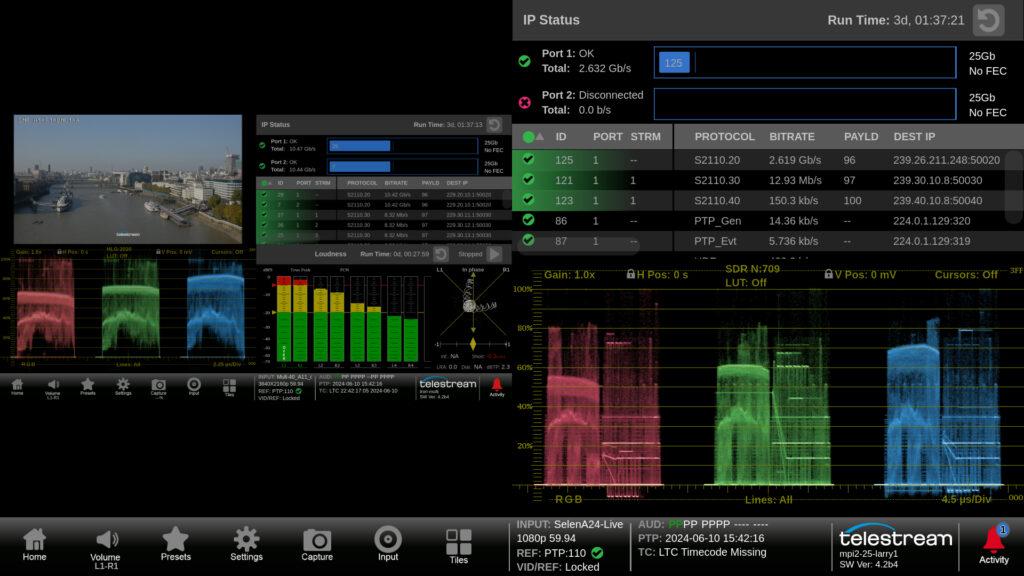
PRISM IP monitoring for ST 2110 is available in three versatile models with support for IP, hybrid, and SDI environments.
System complexity has risen as more of the broadcast industry shifts from SDI to IP for greater flexibility and scalability. PRISM software version 4.2 empowers users with the tools to navigate system complexity and streamline workflows, easing the transition to IP.
Let’s explore how the new features in version 4.2 will streamline the design of IP facilities and how they significantly simplify monitoring systems for modern broadcast facilities:
Save time and money with support for up to eight ST 2110-30/31 audio transport streams
Large sports events that are broadcasted regionally or globally often require multilanguage audio program support. Traditionally, audio tracks of various announcers and commentators from multiple audio booths are combined using different purpose-built equipment. PRISM can dramatically reduce the cost and complication of needing extra equipment with support for up to eight ST 2110-30 streams and direct monitoring of audio transport reducing complications.
Master ANC Data Monitoring with oversight for up to four ST 2110-40 streams

PRISM simplifies the monitoring of multiple ST 2110-30/40 streams without additional equipment.
Broadcast systems are designed to transmit various critical ANC data such as Time Code, VPID, Caption, or SCTE-104 signaling alongside video and audio content. Since each type of ANC data originates from different equipment, a single receiver must be able to handle multiple streams concurrently to monitor all ANC data effectively. PRISM can now act as that single receiver for up to four ST 2110-40 streams, enabling the monitoring of multiple ANC data streams simultaneously and simplifying the ANC data monitoring process.
Eliminate time-consuming caption conversion with direct TTML decoding over ST 2110-43

PRISM is the only IP monitoring solution capable of TTML direct coding, eliminating the need for caption conversion.
Timed Text Markup Language (TTML) is an XML-based caption standard commonly used for packaged media. For broadcast interoperability and compliance, captions are typically converted and transmitted using CEA608/708 and WST standards. PRISM is the first monitoring solution capable of directly decoding TTML over ST 2110-43, without needing to convert to traditional caption standards. This simplifies the process of broadcasting packaged media and provides more seamless integrations for broadcast facilities.
Take advantage of enhanced ST 2110-20 display output routing

PRISM offers flexible transmission of waveform display information to external locations over ST 2110-20.
Waveform monitors are often displayed in a multi-viewer system in the master control room (MCR) to easily share system status. PRISM’s new ST 2110-20 display output feature transmits its user interface over ST 2110-20 through video IP ports. This enables easy routing of the display image to any required location via IP switches. In addition, PRISM MPD models and units using EXTNDSP mode can output two ST 2110-20 streams to transmit both left and right display images.
Enjoy extra peace of mind with VPID over ST 2110-40
While NMOS IS-05 is typically used to route streams to endpoints with SDP, PRISM now also supports VPID. This addition is crucial because SDP data is only accessible during registration, and the endpoint equipment may not receive updated metadata if the source signal is switched without re-registration. VPID ensures continuous tracking of updated metadata to enhance the reliability of PRISM setups and helps detect HDR/SDR content for easy source identification.
Simplify IP configuration with static NMOS registry
The NMOS IS-04 standard requires DNS for NMOS server registration. However, setting up a DNS server or L3 switch can be challenging in real-world scenarios. PRISM now supports both DNS and manual NMOS registry setup, simplifying IP system configuration.
PRISM version 4.2 will be available later this month, June 2024, for current PRISM users. For any questions regarding PRISM version compatibility or for further information, please contact us or click here to learn more.

